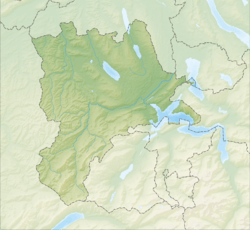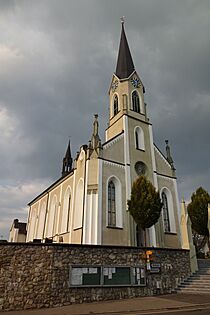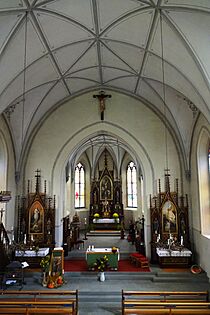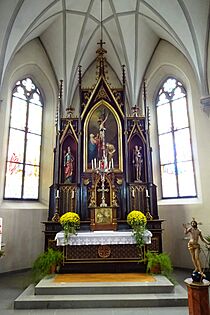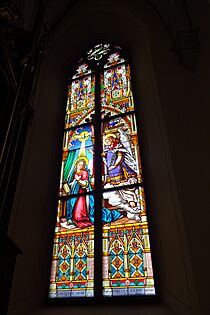Doppleschwand facts for kids
Quick facts for kids
Doppleschwand
|
||
|---|---|---|
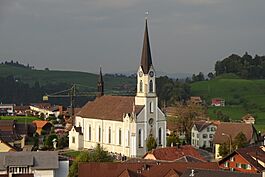 |
||
|
||
| Country | Switzerland | |
| Canton | Lucerne | |
| District | Entlebuch | |
| Area | ||
| • Total | 6.95 km2 (2.68 sq mi) | |
| Elevation | 751 m (2,464 ft) | |
| Population
(Dec 2020 )
|
||
| • Total | 816 | |
| • Density | 117.41/km2 (304.1/sq mi) | |
| Postal code |
6112
|
|
| Surrounded by | Entlebuch, Hasle, Romoos, Wolhusen | |
Doppleschwand is a small town in the canton of Lucerne, Switzerland. It is part of the Entlebuch district.
Contents
History of Doppleschwand
Doppleschwand was first mentioned in old writings in the year 1275. Back then, it was known by names like Togelswande or Towenswande.
Exploring Doppleschwand's Geography
Doppleschwand covers an area of about 7 square kilometers (2.7 square miles). A large part of this land, about 55.5%, is used for farming. Forests cover another big section, about 36.3% of the area.
Only a small part, 5.5%, has buildings or roads. The rest of the land, about 2.7%, is made up of things like rivers or mountains that can't be used for building or farming.
The town itself is a linear village. This means it stretches out in a line, located on a flat area between two rivers, the Grosse Fontanne and the Kleine Emme. Besides the main village of Doppleschwand, there are also smaller communities called hamlets. These include Gober, Holz, and Oberhüseren.
Understanding Doppleschwand's Population
Doppleschwand has a population of 816 people. In recent years, the number of people living here has grown by about 11.9%.
Most people in Doppleschwand speak German. It is the main language for about 97.7% of the residents. Albanian is the second most common language, and a few people also speak Dutch.
Political Choices in Doppleschwand
In the 2007 elections, the most popular political group was the CVP. They received the most votes from the people. Other popular groups included the SVP and the FDP.
Education and Work in Doppleschwand
Many adults in Doppleschwand are well-educated. About 65.6% of people aged 25 to 64 have completed higher education. This means they have gone to a university or a special college.
Most people in Doppleschwand are employed. About 50.4% of the population works. Women make up about 36.2% of the working population.
People in Doppleschwand work in different types of jobs:
- Primary sector: This includes jobs like farming. About 111 people work in this area.
- Secondary sector: These are jobs in manufacturing or making things. About 24 people work here.
- Tertiary sector: This involves service jobs, like working in shops or offices. About 55 people work in this sector.
Religious Groups in Doppleschwand
Most people in Doppleschwand are Roman Catholic, making up about 94.9% of the population. A smaller number of people are Protestant. There are also some people who follow the Muslim faith.
Historical Population Changes
The table below shows how the population of Doppleschwand has changed over many years:
| year | population |
|---|---|
| 1745 | 390 |
| 1798 | 536 |
| 1837 | 681 |
| 1850 | 668 |
| 1900 | 523 |
| 1950 | 502 |
| 1970 | 470 |
| 2000 | 653 |
Pictures
See also
 In Spanish: Doppleschwand para niños
In Spanish: Doppleschwand para niños




